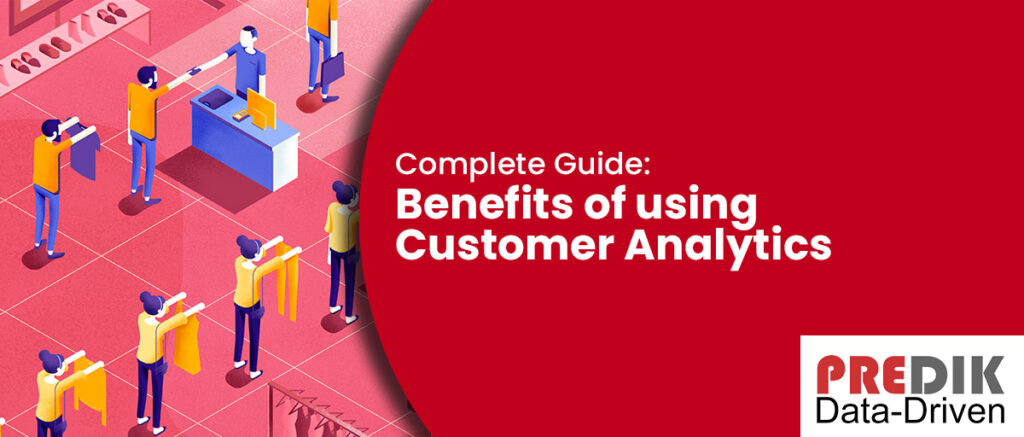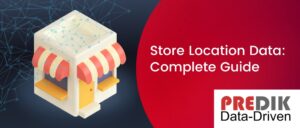There has been a significant shift in consumer habits and expectations when it comes to brand experience. Customers demand immediate results, have higher expectations, want companies to anticipate their needs, and crave hyper-personalized attention.
The market’s demand for fast and high-quality service has put a lot of pressure on many organizations. According to Zendesk’s CX Trends 2024 report, 62% of CX leaders feel they are falling behind in providing instant customer experiences. Also, seven out of ten organizations are currently investing in new methods to capture and analyze customer intent signals.
That is why, now more than ever, companies should pay more attention on developing marketing and commercial strategies based on “customer analytics.”
In this guide we will cover the following topics:
Understanding the concept of customer analytics
Customer analytics involves collecting, analyzing, and interpreting customer interactions and behavior data. This data can be gathered from different digital touchpoints such as websites, apps, social media, and online surveys, as well as offline behavior such as foot traffic, visitation patterns, and mobility behavior.
Learn more: How to Get Useful Customer Behavior Analytics? (Guide)
What is the purpose of having customer analytics?
The main objective of customer analytics is to gain insights into a target audience, which can help businesses make informed decisions and improve their overall performance. Customer data analytics provides insights into customer demographics, preferences, and behavior.
Learn more: Customer Data Analysis: How Customer Data Analysis Increases ROI
What are the benefits of customer analytics?
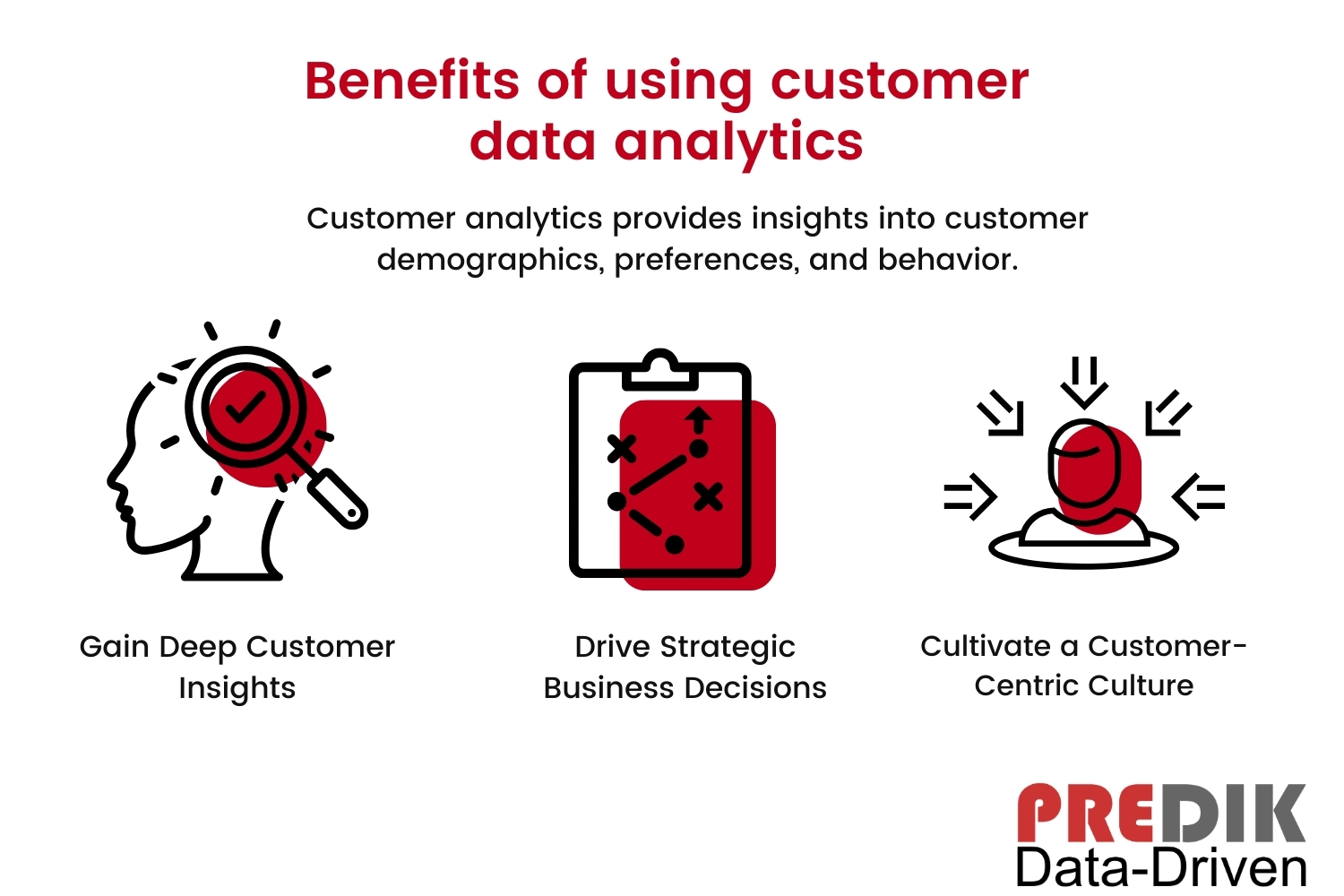
Gain Deep Customer Insights
- Uncover needs and expectations: By analyzing customer data, you can uncover their needs and expectations and tailor products, services, and experiences accordingly.
- Identify profitable segments: Customer segmentation based on demographics, behavior, and preferences helps focus marketing efforts on high-value segments for maximum ROI.
- Understand the customer journey: Comprehending the user’s journey from visitor to customer requires relevant data insights.
- Identify “triggers” that lead to a conversion: Getting the correct customer insights can lead you to understand which are the “musts” your users need to keep consuming your brand.
- Predict customer behavior: Advanced analytics enable you to forecast future customer actions, aiding in proactive engagement and personalized campaigns. Customer data analytics can be used within Predictive Models to predict future customer behavior, leading to more proactive engagement and customized business strategies.
“The majority of consumers now use at least three channels for each purchase journey. And while 75 percent of consumers want a seamless omnichannel experience, only 25 percent are satisfied with the experience that retailers provide.” McKinsey
Drive Strategic Business Decisions
- Optimize marketing campaigns: Having more and better customer insights translates into more effective advertising and promotional campaigns, ensuring your marketing dollars reach the right audience.
- Identify the most profitable revenue channels. Allocating resources effectively to the proper channels requires the right user insights.
- Develop winning products and services: Understand customer needs and pain points, improve product development, and ensure offerings resonate with your target market.
- Set optimal pricing strategies: Analyzing customer behavior and price sensitivity can help establish competitive pricing strategies that maximize revenue.
- Develop better cross-selling and upselling strategies: By collecting valuable customer behavior data, you can increase revenue by identifying opportunities for upselling and cross-selling to your existing customer base.
- Strengthen customer relationships: Analyzing feedback and interaction data can assist in personalizing customer experiences, ultimately leading to increased customer loyalty and retention.
“59% of consumer believe the way they interact with a company will completely change within two years” Zendesk
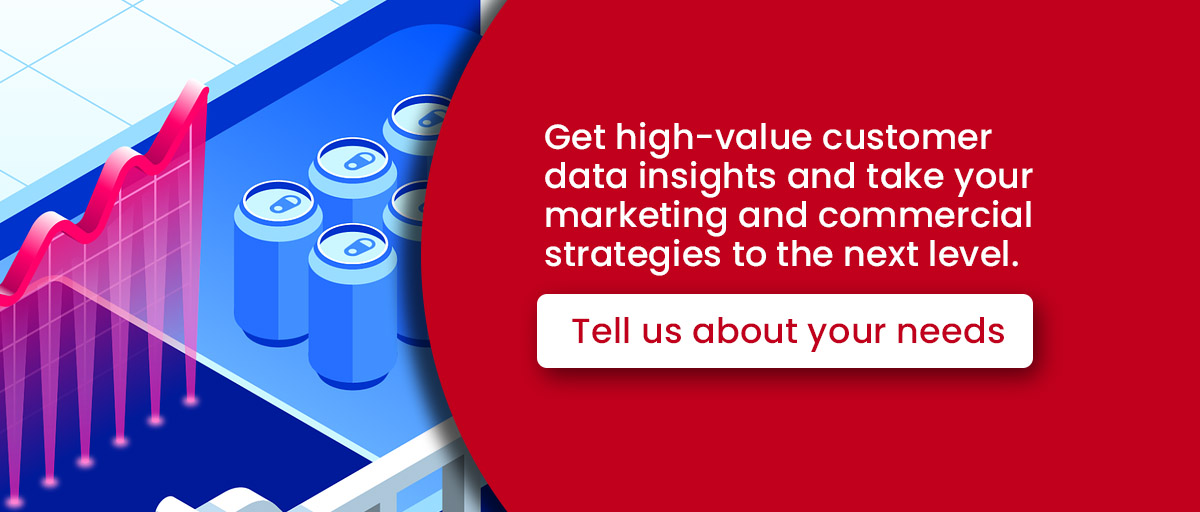
Cultivate a Customer-Centric Culture
- Improve satisfaction and loyalty: Creating positive customer experiences and building loyalty involves deeply understanding the user’s needs and addressing their pain points correctly.
- Acquire new customers. Expanding a customer base enables businesses to reach new, uncovered, and profitable markets.
- Reduce churn and boost retention: Effective customer retention strategies, informed by customer insights, reduce churn and safeguard your customer base.
- Enhance brand reputation: Proactively addressing customer concerns and understanding their sentiment helps establish trust and strengthen your brand image.
“84% of customer service and service support leaders cited customer data and analytics as very or extremely important for achieving their organizational goals in 2023.” Gartner
What industries benefit from customer analytics?
Every industry, from retailers to manufacturers, can benefit from customer analytics; after all, every company has customers. It’s not a question of whether you should use customer analytics but to what extent you should use it.
How does customer analytics work?
Customer analytics should be a collaborative process involving different areas, such as marketing, sales, customer service, IT, and business analysis teams.
The process of customer analytics begins with setting a goal and then collecting data from different sources, followed by organizing and analyzing it. All the required steps are essential to make informed decisions that can help enhance a better user understanding.
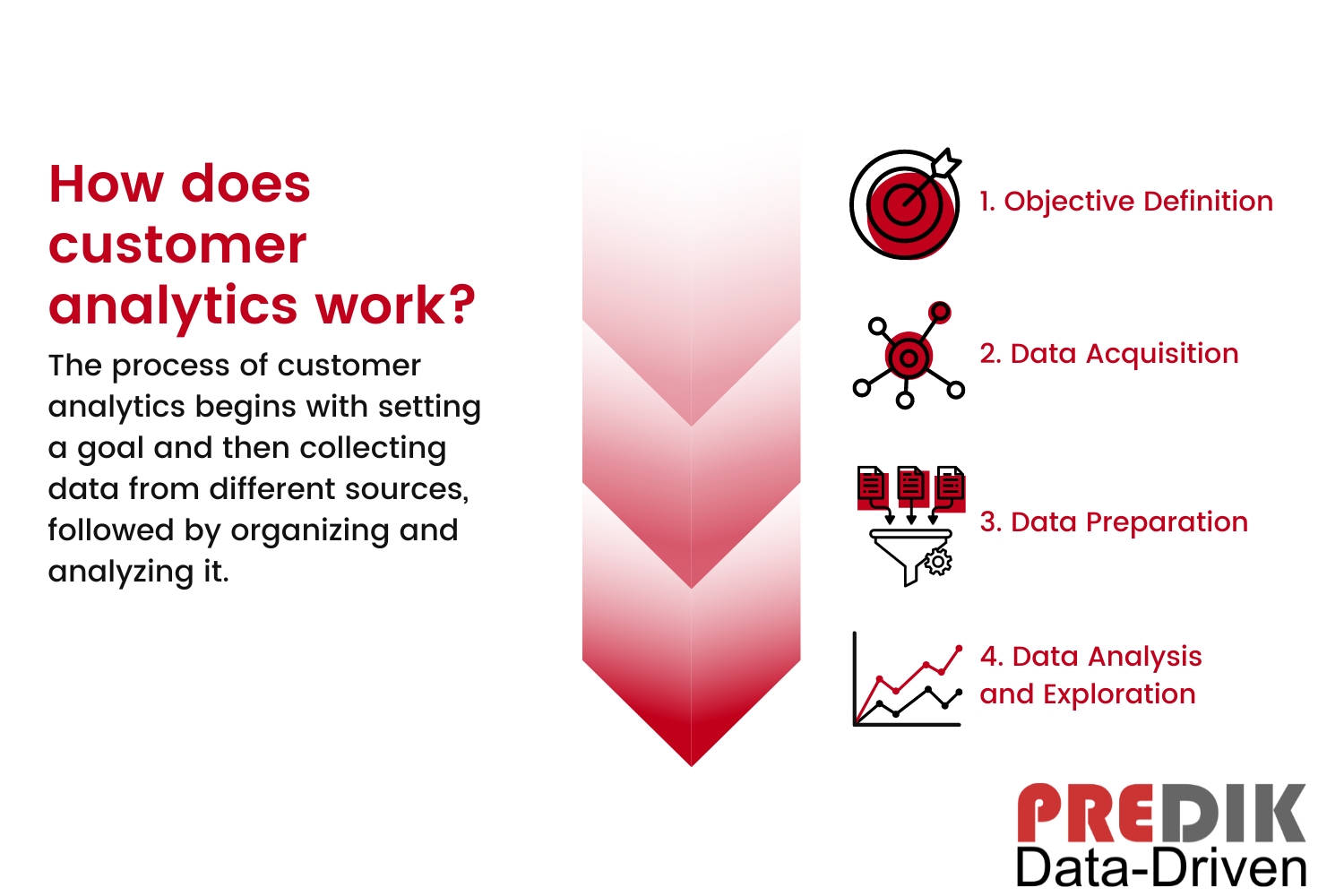
1. Defining the Objective
To get started, it’s essential to have a clear plan. What specific business challenges are you trying to solve? Do you want to improve customer acquisition, increase retention, or optimize marketing campaigns? A clear objective will help you collect and analyze the correct data, ensuring you gather relevant information.
2. Data Acquisition
Data collection involves gathering data from diverse sources such as internal, external, and alternative data.
- Internal data can come from purchase history, current customer demographics, online brand interactions, advertising engagement, interactions with the internal team, and online surveys, among others.
- External data can come from visitation data, spending data, or foot traffic analytics.
- Alternative data can come from consumer transactions, web scrapping, geolocation data, social media insights, and satellite imagery.
Never forget about user privacy
Customer analytics can pose security challenges and concerns when dealing with sensitive customer data. Common security issues include the cost and difficulty of data protection and compliance with privacy regulations.
It is important to mention that both “quality” and “quantity” are essential to get better data analytics.
3. Data Preparation
Your data may have much potential, but it needs to be processed carefully to get real value from it.
The next step is to structure and prepare the collected data for analysis. It is essential to manage all the data obtained from the different sources and ensure they are correctly integrated. Failure to do so may lead to inaccurate customer profiles and insights.
Some key elements that need to be considered when preparing any data are:
- Cleaning and validation: Eliminate errors, inconsistencies, and duplicates.
- Integration and unification: Combine data from diverse sources into a central repository.
- Transformation and formatting: Convert data into a format suitable for analysis.
4. Data Analysis and Exploration
In this step, insights start to emerge, and where customer analytics tools are employed to interpret the organized data.
These tools can identify patterns and trends, represented through charts and graphs, by combining various data points such as demographics and purchase behaviors. For instance, the analysis might reveal that a specific demographic, like middle-income women from Memphis, tend to visit certain shopping areas on Wednesdays after work.
Remember, if you follow each step correctly, you will be able to:
- Identify trends and patterns: Find correlations, segment customers based on characteristics, and uncover hidden relationships within the data.
- Visualization: Turn data into digestible “easy-to-analyze” formats like charts and graphs, making patterns and trends readily apparent.
- Predict outcomes: Forecast future customer behavior and anticipate trends to inform proactive strategies.
Bottom Line
Having reliable and high-value customer data is an effective way to understand the market and plan for future user behaviors and needs shifts. It also helps businesses gain a competitive advantage by providing insights into customer and market trends. Moreover, it can help organizations keep pace with more demanding consumers.
Proper customer data analysis can provide valuable insights into user behavior and market trends, which can help you design effective strategies. By leveraging this data, you can attract new customers and increase average transaction value and lifetime value, leading to improved overall business performance.
Additionally, customer data becomes a helpful input to identify potential issues before they originate, allowing you to develop smart solutions to maximize customer satisfaction and prevent negative experiences that might otherwise cause customers to leave.


